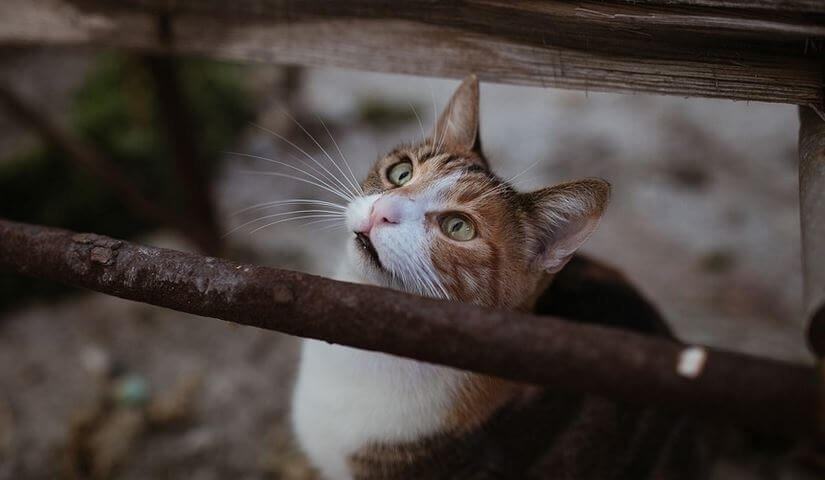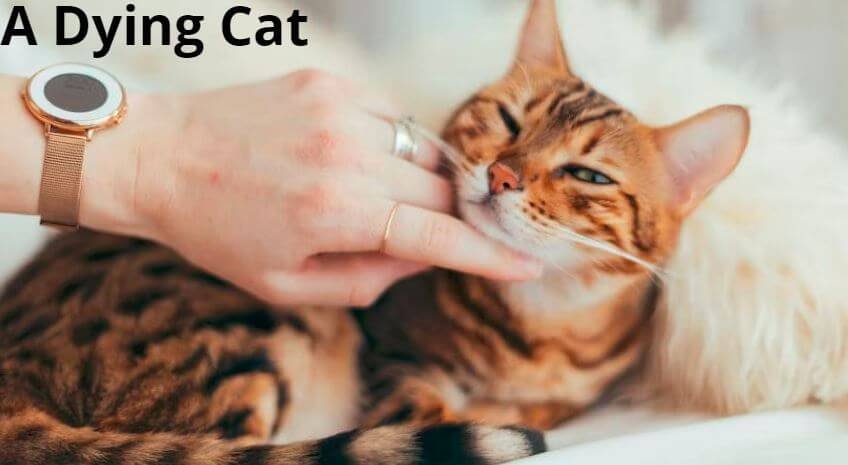It’s distressing to see your cat in the twilight of their life, grappling with the fragility of existence. In such a situation, you only want to know how to comfort a dying cat. This is the only way to ensure a smooth transition of your feline friend into the second life.
You can comfort a dying cat by providing optimum environmental conditions, showing affection, feeding the right food, and taking her to the vet for medication. A dying cat needs a safe, cool, and quiet environment due to its deteriorating body. Therefore, you must provide these conditions for a peaceful and easy dying process.
In the rest of this article, I’ll discuss how to comfort a dying cat using simple tactics. Doing so will see your feline friend off in peace and dignity. Keep reading to learn how to support your lovely cat in her eleventh hour.
1. Provide Optimum Environmental Conditions

As a cat prepares to die, her body starts deteriorating, with most organs shutting down. When this happens, the cat struggles to maintain optimal environmental conditions for her body.
Optimum environmental conditions for your dying cat must have the required temperature range, humidity levels, and air circulation. This provides the best atmosphere for a peaceful passing.
The table below shows the optimal environmental conditions your dying cat needs:
| Environmental Condition | Optimal Threshold |
| Temperature | 37.7 to 39.1°C (99.86 to 102.38°F) |
| Humidity | 30% to 50% |
| Oxygen | 4 liters per minute |
You can comfort your dying cat by ensuring it has the above optimal conditions around it.
Additionally, it’s worth noting that dying cats prefer an environment where they are not disturbed by people, other animals, or environmental stimuli like light. As its body organs continue shutting down, the cat wants protection from elements beyond her control.
Create a separate room where the cat can feel comfortable. The room should have the necessary cat utilities like a comfortable and cozy bed or blanket to support her body and make her journey more manageable. Make sure the cat has enough space around her to stretch out comfortably without being disturbed.
Other considerations to keep in mind for a safe environment include the following:
- The cat should not be tied up or restrained in any way.
- The cat should have a litter box nearby so it can access it easily when needed.
- Ensure the room is free from hazards like sharp objects or chemicals.
Temperature
Temperature is a crucial consideration for a dying cat. Your cat in this state cannot regulate its body temperature as required.
If your sick cat becomes too hot, the consequence is overheating and panting. Ultimately, the cat will be uncomfortable, exposing it to a more painful death.
On the other hand, if the cat becomes too cold, it will be exposed to hypothermia, a condition whereby the cat’s body temperature is below 100° F (37.78°C). When this happens, the cat will be too weak and vulnerable to regulate the heat loss from its body.
Therefore, you should keep the environment at a temperature between 37.7 and 39.1 °C (99.86 and 102.38°F). You can achieve this by:
- Regulating the room’s temperature: Use a thermometer to monitor the room’s temperature. Put the heater off or use an air conditioner to cool the cat if it’s too hot. Otherwise, switch on the heater when it’s too cold.
- Cover the dying cat: If the room is cold and you don’t have a heater, provide an extra layer of covering, like a blanket for the cat. This will help it maintain its body temperature at the necessary level.
Also Read: Do Cats Want to Be Alone When Dying?
2. Show Affection
The most important thing you can do for your dying cat is to show love and affection. Cats need strong emotional support during their last few days, as it helps them feel safe and secure in their final moments.
Show affection by petting the cat gently, speaking softly, or sitting beside her. You can also offer treats like canned food or a special toy to make the cat feel loved, even though it’s in the eleventh hour.
Petting your dying cat helps in the secretion of oxytocin, a feel-good hormone that lowers blood pressure. When this hormone is secreted from the cat’s brain, it lowers cortisol levels, thus relieving stress and anxiety.
Although the cat cannot understand some of the affectionate things you do for her, physical affection goes a long way in helping her feel comfortable in her last few days.
Needless to say, it’s essential to observe your pet’s demeanor to know how much attention she can tolerate. Some cats in their dying moments, will not tolerate excessive physical contact.
3. Feed the Right Food
Although most dying cats have poor appetites, it’s your responsibility to assess the cat’s situation and feed it.
A dying cat needs a balanced diet high in protein, fats, and essential vitamins. These nutrients serve to help the cat’s body organs regulate their functioning and keep energy levels up.
When comforting a dying cat by feeding it, you should not forget the minerals that strengthen the body. Such minerals will reduce the amount of pain the cat experiences at this challenging time. You should prioritize the following minerals:
- Calcium: It strengthens the bones and teeth while providing energy.
- Potassium: It helps keep blood pressure levels in check and maintains optimal electrolyte balance in the body.
- Phosphorus: It aids in metabolism, digestion, and other vital bodily functions.
In terms of meals, it’s advisable to feed the cat soft food as this is easier to digest for a dying cat in its weakened state.
Here is a procedure to help you prepare soft food for your dying feline friend:
- Choose high-quality canned or wet food.
- Warm the food until it’s at room temperature.
- Mash the food into a soft, smooth paste.
- Put the meal in a bowl and place it close to your cat.
Ensure to remove any uneaten meal portions after 20 minutes to prevent bacterial growth and contamination.
It’s important to stay vigilant and observe your cat during mealtime. If the cat cannot eat on its own, you may need to provide spoon feeding or syringe feeding of soft food into its mouth. This will ensure that they are adequately nourished.
It’s essential to consult your vet before deciding on any meal plan for your cat. Doing so ensures the cat gets all the required nutrients to sustain her in the dying journey.
4. Taking the Cat to the Vet for Medication

Most feline parents tend to ignore taking their dying cats for medication. However, it’s important to note that a vet can provide medications to help the cat in its final days.
The most common medication for dying cats is pain relief drugs. These drugs reduce the amount of pain and discomfort felt by dying cats. They also lower inflammation and swelling, allowing them to breathe more comfortably. In turn, this helps the cat to have a more peaceful death.
The vet may also prescribe medications to reduce nausea, vomiting, and diarrhea. These can help the cat maintain its nutrition level and reduce its suffering in its last days.
It’s essential to regularly take your dying cat for the prescribed medication as this allows the pet to live out her final moments peacefully.
While losing your pet is painful, the vet will also console you as you prepare for the last day. Having dealt with similar situations from other feline parents, the vet will share their experience and provide the best advice.
Remember that you’re not alone, and there are many people out there who understand your situation.
5. Maintain the Cat’s Hygiene
A crucial way to comfort a dying cat is by grooming it to the letter.
Cats are self-grooming animals that spend between 30 and 50 percent of their time grooming. However, when a cat is feeling unwell, it can’t groom itself properly, which might lead to poor hygiene and infections.
A dying cat’s body is generally weak and deteriorating, meaning it lacks the necessary grooming energy.
Since cats love grooming themselves and keeping their unruly hair in shape, your dying feline is uncomfortable staying unhygienic. However, the current situation doesn’t allow it to groom naturally.
You can comfort your dying cat by maintaining her hygiene in the following ways:
- Brushing her fur regularly: This helps remove debris and keeps her fur tidy. Consequently, brushing the fur means the cat will not be affected by parasites like mites.
- Trimming the nails: Trimmed nails prevent your cat from scratching itself, which could be painful due to its weakened state.
- Cleaning the eyes and ears: Wiping off any dirt or discharge in the eyes and ears prevents infection from building up.
- Bathing the cat with lukewarm water: This will help reduce any odor and keep its fur clean.
Expert Tip: The grooming process can be uncomfortable for a dying cat. Therefore, you should approach it with patience and caution. Avoid being harsh while scrubbing the fur or removing dirt from the eyes and ears.
6. Toilet Assistance
Cats are hygienic pets that will always use their litter boxes to do their business. However, due to the cat’s weakened state, it may not be able to use the litter box properly.
Waking up to look for the litter box will be challenging. Therefore, it’s your responsibility to comfort the dying cat by ensuring it can relieve itself easily.
It’s essential to create an area where the cat can comfortably and safely relieve itself. This could involve making a shallow container filled with sand or a special absorbent material. You may also need to line the area with towels for easy clean-up.
After relieving itself, you should clean up the mess to ensure the cat is comfortable.
The most important thing to remember when comforting a dying cat is to be patient, kind, and gentle. Be sensitive towards your feline’s needs and provide as much comfort as possible.
Remember that this challenging time can be a rewarding experience if you’re willing to provide your dying pet with the necessary care and comfort. You can achieve this by adhering to the above tips on how to comfort a dying cat.
Frequently Asked Questions (FAQs)
Should I comfort a dying cat?
You should comfort a dying cat because it’s a time for offering love, understanding, and support. It’s essential to provide your cat with the same level of comfort as it did for you every day before falling sick.
How do cats behave when they are dying?
Cats display behavioral changes when they are dying. Some cats become lethargic with poor appetite, while others hide a lot. Overall, you will notice changes in your cat’s behavior when nearing the end of its life.
What Can I Give My Dying Cat for Comfort?
You can give your dying cat easily digestible meals and fresh water if the cat is still eating. You can also try offering special foods designed for sick or elderly cats. Besides, ensure the dying cat has a soft and warm place to rest. Provide a quiet and peaceful environment where they can feel safe.
Should I Give My Dying Cat Water?
You can give your dying cat water if she still has the appetite to eat and drink. Of course, you want to use a syringe to give your dying cat water as she may not have the needed energy to drink it normally.


This was very helpful. Thank you. Can your cat hear you those last 2 days?